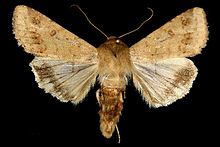| Helicoverpa zea | |
|---|---|

| |

| |
| Scientific classification | |
| Domain: | Eukaryota |
| Kingdom: | Animalia |
| Phylum: | Arthropoda |
| Class: | Insecta |
| Order: | Lepidoptera |
| Superfamily: | Noctuoidea |
| Family: | Noctuidae |
| Genus: | Helicoverpa |
| Species: | H. zea
|
| Binomial name | |
| Helicoverpa zea (Boddie, 1850)
| |
| Synonyms | |
| |
Helicoverpa zea, commonly known as the corn earworm, is a species (formerly in the genus Heliothis) in the family Noctuidae.[1] The larva of the moth Helicoverpa zea is a major agricultural pest. Since it is polyphagous (feeds on many different plants) during the larval stage, the species has been given many different common names, including the cotton bollworm and the tomato fruitworm. It also consumes a wide variety of other crops.[2]
The species is widely distributed across the Americas with the exception of northern Canada and Alaska. It has become resistant to many pesticides, but can be controlled with integrated pest management techniques including deep ploughing, trap crops, chemical control using mineral oil, and biological controls.
The species migrates seasonally, at night, and can be carried downwind up to 400 km. Pupae can make use of diapause to wait out adverse environmental conditions, especially at high latitudes and in drought.
- ^ Lambert B, Buysse L, Decock C, Jansens S, Piens C, Saey B, et al. (January 1996). "A Bacillus thuringiensis insecticidal crystal protein with a high activity against members of the family Noctuidae". Applied and Environmental Microbiology. 62 (1): 80–6. Bibcode:1996ApEnM..62...80L. doi:10.1128/AEM.62.1.80-86.1996. PMC 167775. PMID 8572715.
- ^ Light DM, Flath RA, Buttery RG, Zalom FG, Rice RE, Dickens JC, Jang EB (September 1993). "Host-plant green-leaf volatiles synergize the synthetic sex pheromones of the corn earworm and codling moth (Lepidoptera)". Chemoecology. 4 (3–4): 145–52. doi:10.1007/BF01256549. S2CID 21610251.